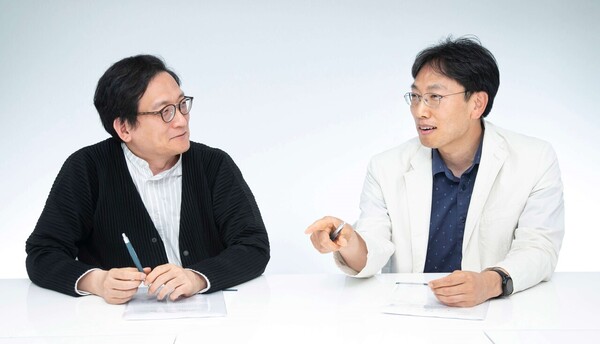Fungal infections are lesions caused by fungi in the blood or tissues. They are especially fatal to patients with hematologic diseases and cancers and are immunocompromised by intense chemotherapy or hematopoietic stem cell transplantation. The mortality rate of invasive fungal infections is about 50% in patients with hematologic malignancies and up to 87 percent in patients with allogeneic stem cell transplantation.
Aspergillosis, which accounts for 81 percent of fungal infections in patients with blood cancer, is a common invasive fungal infection. If not diagnosed and treated early, it can invade surrounding tissues, such as lungs and blood vessels, and cause hemoptysis and respiratory failure.
Especially in neutropenic patients, it has been reported to progress rapidly to become a vascular invasive infection within hours. In addition, the presence of aspergillosis in patients with acute myeloid leukemia has been associated with an adverse prognosis, with two-year survival rates plummeting from 32 percent to 14 percent.
Despite such a devastating prognosis, invasive aspergillosis has no specific early symptoms and progresses rapidly, with many patients dying before the causative strain is identified. As a result, “empirical treatment” has been practiced to reduce the mortality rate by rapidly administering antifungal drugs even before identifying the causative strain.
As the risk of fungal infections is emerging along with the increase of blood cancer patients in Korea, it will likely become increasingly important to treat and manage fungal infections in blood cancer patients.
Against this backdrop, Korea Biomedical Review (KBR) met with Professor Lee Dong-gun of the Department of Infectious Diseases at the Catholic University of Korea Seoul St. Mary’s Hospital, an expert on fungal infections, and Professor Kim Sung-yong of the Department of Oncology and Hematology at Konkuk University Medical Center, an expert on blood cancer, to learn about their strategies for treating fungal infections in Korean blood cancer patients.

KBR: Over the past three years, public awareness of infectious diseases has increased as the world has experienced the Covid-19 pandemic. Has Covid-19 affected the occurrence of fungal infections?
Lee: Covid-19 is a virus that enters the respiratory tract and attacks the immune system, increasing the risk of secondary infections such as bacterial and fungal infections.
Unlike healthy people who maintain their immunity, people with severely compromised immunity, including cancer patients, are more susceptible to secondary infections when infected by Covid-19.
KBR: As the numbers of blood cancer patients and hematopoietic stem cell transplant patients in Korea steadily increase, we are curious about the actual scale of fungal infections among them and how they are treated.
Lee: It is estimated that fungal infections occur in about 10-15 percent of all acute leukemia patients. Treatment should begin with broad-spectrum antifungal agents before the causative organism is identified for quick and effective treatment of suspected fungal infections. Once the causative organism is identified, treatment should be tailored to target that organism.
Unlike other diseases, infectious diseases have a common strategy of starting empiric antibiotic therapy before making an accurate diagnosis. Because infectious diseases are expensive and time-consuming to diagnose, and the prognosis of patients deteriorates rapidly with delayed treatment, it is best to begin antifungal or antibiotic therapy as early as possible.
KBR: What are the symptoms of suspected fungal infection in patients with hematologic carcinoma?
Kim: Some patients with acute leukemia already have neutropenia before they come to the clinic, and in rare cases, they are diagnosed with acute leukemia in a state of infection with fungi. Once chemotherapy is initiated, neutrophils decrease dramatically, significantly lowering immunity and increasing the risk of fungal infections.
If a neutrophil count of less than 500/mm3 for more than two to three weeks in acute leukemia patients, most develop a fever. And if the fever does not resolve despite broad-spectrum antimicrobials, it can be suspected of a fungal infection.
In high-risk patients, fungal antigens in the blood are routinely monitored for additional confirmation of fungal infection. Antifungal medications may be administered prophylactically, especially in patients with acute myeloid leukemia and myelodysplastic syndromes, as they are at higher risk for fungal infection.
Lee: Additionally, fungal infections can also be suspected if a patient's white blood cell count remains low or has a persistent fever despite antibiotics.
KBR: We are also curious about the impact of fungal infections on the prognosis of blood cancer patients and hematopoietic stem cell transplant patients.
Lee: It is difficult to conclude that fungal infections directly cause death in patients with hematologic malignancies because most blood cancer patients have coexisting infectious diseases and may have other bacterial or viral infections besides fungi. However, fungal infections in patients with blood cancer can be fatal if not treated timely and properly.
Candida, one of the most common fungi, normally resides in the gastrointestinal tract. However, in blood cancer patients whose immunity is weakened by chemotherapy, the mucous membrane is damaged, and Candida can penetrate the mucous membrane and cause invasive infections. In other words, receiving chemotherapy can make one vulnerable to fungal infections. Aspergillosis and candidiasis are deadly, with a mortality rate of 30 percent within 100 days of infection.
KBR: If 30 percent of patients die within 100 days of a fungal infection, it seems like early treatment is the most important thing. What is the timeline for treatment in the clinical field?

Kim: It varies case by case, but in high-risk patients with acute myeloid leukemia or myelodysplastic syndromes, antifungal medications are often used to prevent fungal infections, even if the patient has no symptoms. However, prophylactic treatment is not 100 percent effective in preventing fungal infections, and breakthrough infections can occur even after treatment.
If patients’ neutrophil count continues to drop and they develop a fever, antibiotics should be prescribed first. A fungal infection is suspected if symptoms do not improve after a prescription of antibiotics. And if an X-ray shows pneumonia or a positive galactomannan or beta-D-glucan test, we quickly initiate empiric antifungal therapy.
KBR: What empiric antifungals can be prescribed at this stage of empiric therapy? Do different spectrums of antifungals affect fungal infections?
Lee: Current empiric antifungal agents for neutropenic fever include ambisomal and caspofungin. Since empiric therapy is a strategy of prescribing antifungal drugs before diagnosing the exact causative organism to provide faster treatment when symptoms of a suspected fungal infection occur, it is advantageous to use antifungal drugs that can treat a broader spectrum of fungi.
About 95 percent of fungal infections in patients with hematologic malignancies are aspergillosis, candidiasis, and mucormycosis. Aspergillosis and candidiasis are effectively treated with both Ambisome and Caspofungin, but Caspofungin is ineffective, and only Ambisome is effective on mucormycosis. Thus, the therapeutic spectrum of an antifungal agent has a significant impact on empirical treatment outcomes.
KBR: What therapeutic benefits can one expect from prescribing Ambisome?
Lee: Ambisome is an antifungal drug developed by liposomalizing amphotericin B. The action disrupts fungal cell membrane function by transporting the drug to the site of fungal infection via very small nanoparticles. Amphotericin B, the main component of Ambisome, has not experienced any significant resistance to Aspergillus species for 60 years since its development in 1958.
When prescribing antifungal drugs to cancer patients, if the dose or concentration of antifungal drugs is not controlled, kidney damage may occur, or side effects may increase with long-term treatment. However, despite long-term treatment, Ambisome has not been reported to have these problems. In addition, the azole-family antifungal drugs have drug interaction problems with chemotherapy drugs and immunosuppressive drugs used in cancer patients. Still, Ambisome has fewer drug interaction problems and can be combined with chemotherapy drugs.
KBR: Ambisome has been on global markets for 30 years. We assume there have been attempts to develop generic versions.
Lee: Ambisome has been on the market for 30 years, but no successful generic drugs exist worldwide. Ambisome is a drug with a unique liposomal delivery system that uses very small nanoparticles as a carrier to deliver the drug throughout the body effectively. It is important to keep the nanoparticles very small and uniform because any change in nanoparticle size can block capillaries and cause adverse reactions in patients. However, this is a very advanced technology, and continuous quality control is difficult, making it challenging to develop generic drugs. Clinical trials are also underway in Korea to develop a generic Ambisome. However, when generic drugs are mass-produced and commercialized, it has yet to be determined whether the nanoparticle size can be kept small and uniform at the level of Ambisome to ensure safety.
KBR: What improvements could be made to treat fungal infections in Korea?

Lee: Until about a decade ago, antifungal use was always prioritized as an afterthought, and the right drugs were not available. Fortunately, as policymakers moved toward enhancing the coverage of cancer patients, the reimbursement environment for antifungal drugs has improved, and we have been able to introduce the current antifungal drugs based on the risk of fungal infections in cancer patients. However, there are still too many limitations to treat fungal infections in Korea properly.
First, when using Ambisome in empirical treatment, the maximum licensed dose in Korea is 5mg/kg, so health insurance does not cover higher doses. In the case of mycosis fungoides, a potentially fatal fungal infection, European treatment guidelines recommend higher doses of Ambisome up to 10 mg/kg. However, restrictive domestic product approval and reimbursement criteria make it difficult to provide adequate treatment.
Another problem is that health insurance only covers empiric antifungal therapy during the temporary period of low white blood cells. Patients whose white blood cell counts have recovered but have a poor prognosis and need to continue antifungal treatment are not covered by health insurance and cannot be properly treated. In other words, an antifungal treatment that meets international treatment guidelines is impossible due to restrictive health insurance coverage standards in Korea.
The U.S. and European treatment guidelines cover the latest treatment opinions and can be universally applied in all countries, including Korea. Currently, limited treatment is provided in Korea based on domestic health insurance coverage standards instead of international treatment guidelines. The domestic health insurance coverage standards should be set in line with international treatment guidelines. If an environment is created where the best treatment can be provided according to international treatment guidelines, it will be very helpful for medical staff and patients.
Kim: It is important for the health authorities to objectively calculate the social benefits of using drugs recommended by international treatment guidelines, which are trusted by medical professionals, and come to such a consensus.

